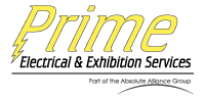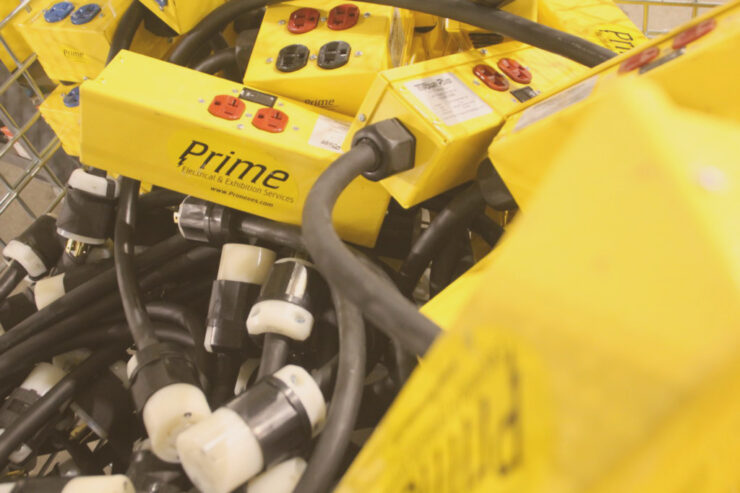Power
Bringing life to your event
Our Services
Here’s a refresher on utility services. If you have any questions, please don’t hesitate to call 312-226-6738 or email chicago@PrimeEES.com.
We’ve got you covered.
Amps, Volts, Watts
To support in approximations we suggest referencing the nameplate or stamp generally located on the back or bottom of any electrical device then order the corresponding outlet for each piece of equipment to avoid tripping/outages during the event.
The formula for calculating power is: Amps (A) X Volts (V) = Watts (W)
- 500 watts = 5 amps
- 1000 watts = 10 amps
- 1500 watts =15 amps
- 2000 watts = 20 amps
For a quick guide to power and wattage, click here.
Orders and Payment Information
Prices for outlets are for the entire show, not per day or by the hour. Advanced rates or regular rates depend on the date your order is received. The deadline date for discounted rates is listed online and on the order form. If an electrical layout is required, please submit before the deadline date to be eligible for the discounted rate. All orders and/or electrical layouts received after the deadline date are subject to the regular rate.
Calculating Power
When calculating the amount of power needed for your exhibit, you’ll first want to think about booth layout/design and all of the equipment that requires power. Electric to run equipment is usually measured in amps. If you need assistance determining the amount of power a piece of equipment requires, read the ratings from the metal plates or stamps usually located on the bottom or back of equipment. Note that any piece of equipment that plugs into a standard wall outlet found in your home or office will require 120-volt/basic power. This includes most office equipment, lights and home devices.
Calculating Lighting
Power for lighting fixtures is generally measured in watts. You can determine the amount of electric your exhibit lighting requires by adding the wattage of each bulb. Wattage information can typically be found on the packaging or the bulb itself. Wattage is the number printed on the top of the bulb or possibly on the metal base of the bulb.
120-Volt
Once you’ve determined the total wattage for each 120-volt device in your booth, mark each piece at its location in the booth. You will need to order an outlet that meets or exceeds the total amount of power needed at each location. Separate outlets should be ordered for each power location to help minimize disturbances. You might also consider the number of plugs needed. It is best to overestimate power needs rather than underestimate, especially if you plan to use a vacuum in your booth during the run of the show.
Connection Points & Plugs
There is generally one connection point per outlet ordered. When placing your order and designing your electrical layout, think about general areas of your exhibit where power could be united from a single outlet or strip. Consider the electrical load and how many items will be plugged in per outlet. Please note power strips offer six outlets but are only rated for 15 amps. If you need more outlets for low-wattage lights or devices, you may want to consider ordering multiple smaller outlets (i.e., two 10-amps rather than one 20-amp) to create additional plugs. Orders exceeding 120 volt/20 amps only provide one connection point and strips cannot be provided. Labor is also required.
24-Hour Power
After you’ve calculated how much power your exhibit requires, determine whether you will need 24-hour power to any of your equipment. Not all outlets have to be ordered on 24-hour power, only those that need it. Most facilities in Chicago require power to be turned off one-half hour after the show closes and restored one-half hour before the show opens. If any of your equipment requires uninterrupted power (charging stations, refrigerator’s, etc.) please consider ordering 24-hour power. It is generally double the rate.
High-Voltage
Machinery, medical devices and industrial cooking devices generally use 208-volt or 480-volt power, which is ordered by single or three-phase. Wattage and/or amperage cannot be combined for a 208-volt or 480-volt apparatus. Each require separate outlets. Voltage ratings are placed on the metal plates attached to the unit. All three ratings are needed to order the correct service.
Example: This rating below indicates the equipment runs on 30 amps of 208-volt three-phase power.
V208
A30
PH3
As an exhibitor, you will save time and money if you use equipment that is prewired to plug directly into Prime’s electrical distribution. The following list will ensure the proper connection:
-
- 500 Watts to 2000 Watts – Standard U-Ground 20 Amp Cord Cap
- 20 Amp 120/208 5 Wire – Hubbel Male – HBL 2513 / L-2120C
- 30 Amp Y277/480 5 Wire – Hubbel Male – HBL 2821 / L-2230P
- 60 Amp 208v & 480v Daniel Woodhead 5 Wire – Male Y560P
- 100 Amp 208v & 480v Mini-Cam – Male Leviton 15SDM – Female 15SDF
- Hots – Male Neutral & Ground – Female
- 200 / 400 Amp 208v & 408v Large-Cam – Male Hubbel HBL 400P5 EKE – Female Hubbel HBL 400CT
- Hots – Male Neutral & Ground Female
All of the above items may be found at your local electrical wholesale houses. Should you require any additional information, please contact our office.
Locations
Depending on the facility and location within a facility, power can come from the floor port, overhead sources, wall outlets, columns or a combination of these four locations. If the location where your power is pulled from is a concern, please call our office for additional information.
Drops and Booth Types
There are four different types of trade show booths. In-line, peninsula, back-to-back peninsula and islands.
- In-line, peninsula and back-to-back peninsula booths will find their main power source on the floor, along the rear of the booth at the perimeter drape line. Exhibitors requiring electricity at any location other than the back of the booth must submit an electrical layout.
- Island booths need to submit an electrical layout and designate one location for each outlet ordered. Multiple outlet locations will be charged on a time and material basis. Note: If you fail to provide us with an electrical layout, we will bring power to a location at our discretion and all other distribution will be billed on a time and material basis.
Electrical Layouts
An electrical layout should provide the electrician an overhead view of your booth, indicating specific dimensions for power requirements of each electrical outlet and the orientation of your booth on the show floor. This ensures that electrical boxes and wiring are not visible once the exhibit is complete. When a layout and order are provided in advance, Prime will complete the floor work before you arrive so there is no interruption in assembling your booth. Once carpet is laid, installing or changing electrical services becomes much more time consuming and potentially costly.
The electrical layout should be legible, to scale and provide exact measurements to each outlet, along with neighboring booth numbers. For island booths, a main drop location must be listed, as it will be the location from which other outlets are fed. Note that each power distribution point should have a minimum of 5 amps. Please double check the power allotted on the booth layout matches the outlet(s) ordered.
NOTE: Layouts should be completed with all necessary information and submitted prior to the deadline date in order to qualify for advance rates. Layouts are not mandatory if all outlets are located at the back wall in inline/peninsula booths.
YOUR POWER EXPERTS
SEE WHAT WE CAN DO FOR YOU

